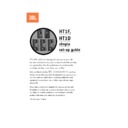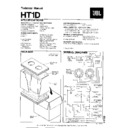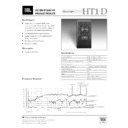JBL HT 1D (serv.man3) User Manual / Operation Manual ▷ View online
one.
Speaker Placement
The HT1F and HT1D are THX®
licensed home theater loud-
speakers. When combined with
the HT PS300 powered sub-
woofer, a THX controller, and
licensed home theater loud-
speakers. When combined with
the HT PS300 powered sub-
woofer, a THX controller, and
THX amplifiers, the
JBL HT Series loudspeaker
system will deliver state-
of-the-art home theater
experience to your home.
JBL HT Series loudspeaker
system will deliver state-
of-the-art home theater
experience to your home.
The HT Series loudspeakers
also deliver clear accurate
stereo music reproduction.
also deliver clear accurate
stereo music reproduction.
Introduction
Properly placing your speaker
components is vital to achiev-
ing the maximum sonic per-
formance. Please follow the
recommendations in this
guide, to properly position
your speakers.
components is vital to achiev-
ing the maximum sonic per-
formance. Please follow the
recommendations in this
guide, to properly position
your speakers.
Note: Do not attempt to
install any type of mounting
brackets onto your speakers.
Drilling Holes in the product
or improperly installing
mounting brackets may void
your JBL warranty and cause
install any type of mounting
brackets onto your speakers.
Drilling Holes in the product
or improperly installing
mounting brackets may void
your JBL warranty and cause
a safety hazard. Contact JBL
or your dealer/installer for
additional information.
or your dealer/installer for
additional information.
<2 ft.
• The left and right speakers
should be at the exact same
height, with the tweeter’s
height positioned at the
midpoint of the screen.
should be at the exact same
height, with the tweeter’s
height positioned at the
midpoint of the screen.
• The center channel speaker
must be vertically oriented.
Placing the speaker horizon-
tally will result in less precise
center channel performance.
must be vertically oriented.
Placing the speaker horizon-
tally will result in less precise
center channel performance.
• If necessary, tilt the center
channel so that the tweeters
are aimed at the listening area.
channel so that the tweeters
are aimed at the listening area.
HT1F Front Channel Loudspeakers
Placement Tips
Direct view or rear
projection TV.
projection TV.
Front projection system.
Place center speaker behind
acoustically transparent
screen.
Place center speaker behind
acoustically transparent
screen.
<2 ft.
Alternate front speaker
placement.
placement.
HT1F, HT1D OM 7/22/98 2:39 PM Page 2
Preparing the Speaker Cable
1. Determine the length of
wire necessary to connect
your amplifier to the speaker
farthest away. Remember to
allow for extra cable to be
able to conceal it under
baseboards, run it around
corners, etc.
wire necessary to connect
your amplifier to the speaker
farthest away. Remember to
allow for extra cable to be
able to conceal it under
baseboards, run it around
corners, etc.
2. Make the cables for both
speakers this length. Keeping
both cable lengths the same
will help maintain proper
signal balance and imaging.
3. Separate the two conduc-
tors that make up each cable,
for about one inch. Then strip
off about 3/8" of insulation.
speakers this length. Keeping
both cable lengths the same
will help maintain proper
signal balance and imaging.
3. Separate the two conduc-
tors that make up each cable,
for about one inch. Then strip
off about 3/8" of insulation.
4. Twist each conductor’s thin
wires into a tightly bunched
spiral.
5. Identify a difference
between the two conductors.
This may be done in various
ways, depending upon the
type and brand of cable you
are using.
wires into a tightly bunched
spiral.
5. Identify a difference
between the two conductors.
This may be done in various
ways, depending upon the
type and brand of cable you
are using.
• Different color wire
• A strand of thread in one
conductor
• A strand of thread in one
conductor
• A colored line on one con-
ductor’s outer insulation
• Raised ribs on one conduc-
ductor’s outer insulation
• Raised ribs on one conduc-
tor’s outer insulation
• A printed (+) marking on
one of the insulators
• A printed (+) marking on
one of the insulators
Some of the More Common Differentiating Marks Are:
Wire Length
Recommended Speaker Cable Size
Up to 20 ft.
16 gauge
Up to 50 ft.
14 gauge
Greater than 50 ft.
12 gauge or heavier
two.
Hookup
Connection Tips
– +
– +
– +
– +
– +
Front Speakers
Left Center Right
Left
HT1F
Right
HT1F
– +
Center
HT1F
Receiver/Amplifier
– +
– +
– +
– +
Surround Speakers
Left Right
Left
HT1D
Right
HT1D
HT1D
Receiver/Amplifier
HT1D
HT1F
HT1F, HT1D OM 7/22/98 2:39 PM Page 3
2 – 3 ft.
HT1D Surround Loudspeakers
• Place the surrounds to the
sides, or slightly behind, the
listening position with the
speaker terminals placed
against the wall.
sides, or slightly behind, the
listening position with the
speaker terminals placed
against the wall.
• Place surround speakers
with the port tubes facing the
screen. (One speaker will
appear “upside-down”. This
will not affect sound quality.)
with the port tubes facing the
screen. (One speaker will
appear “upside-down”. This
will not affect sound quality.)
Placement Tips
Alternate surround
placement.
placement.
HT1F, HT1D OM 7/22/98 2:39 PM Page 4
If the sound seems to come
from instead of between
the speakers, check the
following:
the speakers, check the
following:
• Make sure the polarity
(+ and –) of the speaker
inputs are connected properly.
• The speakers are too far
from the back or side walls or
are too far apart. Experiment
with the speaker placement.
(+ and –) of the speaker
inputs are connected properly.
• The speakers are too far
from the back or side walls or
are too far apart. Experiment
with the speaker placement.
If there is very low or no
output from any of the
speakers, check the
following:
output from any of the
speakers, check the
following:
• Receiver or processor/
amplifier is on and a source is
playing.
• Review proper operation of
your receiver/processor.
amplifier is on and a source is
playing.
• Review proper operation of
your receiver/processor.
If there is very low or no
output from one or more
speakers, check the
following:
output from one or more
speakers, check the
following:
• Check the “Balance” control
on your receiver/processor.
• Check the surround level on
your receiver/processor.
• Check all wires and connec-
tions between the receiver/
amplifier and the speakers.
Make sure all wires are con-
nected and that none of the
speaker wires are frayed, cut,
or punctured.
• Review proper operation of
your receiver/processor.
on your receiver/processor.
• Check the surround level on
your receiver/processor.
• Check all wires and connec-
tions between the receiver/
amplifier and the speakers.
Make sure all wires are con-
nected and that none of the
speaker wires are frayed, cut,
or punctured.
• Review proper operation of
your receiver/processor.
If the system plays at low
volumes but shuts off as
volume is increased, check
the following:
volumes but shuts off as
volume is increased, check
the following:
• Check all wires and con-
nections between receiver/
amplifier and the speakers.
Make sure all wires are con-
nected and that none of the
speaker wires are frayed, cut,
or punctured.
• If more than one pair of
speakers is being used, check
the minimum impedance
requirements of your receiver/
amplifier.
nections between receiver/
amplifier and the speakers.
Make sure all wires are con-
nected and that none of the
speaker wires are frayed, cut,
or punctured.
• If more than one pair of
speakers is being used, check
the minimum impedance
requirements of your receiver/
amplifier.
Troubleshooting
HT1F, HT1D OM 7/22/98 2:39 PM Page 5
Display




